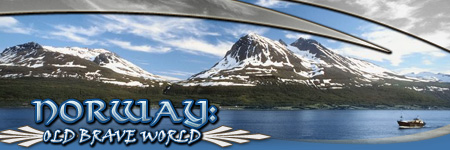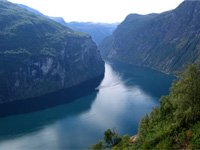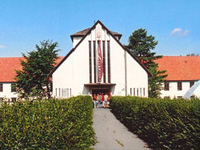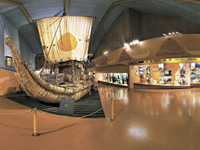|

Uncovering Norway's Cool Arctic Past
by Amanda Castleman
The Zodiac slaps up the fjord. I crouch in the bow, one hand laced under the plastic lifeline, the other holding my fleece hat. Norway smells of firs and salmon and saltspray. The Arctic breeze holds an undertone of iceberg too.
 |
Norway Fjord |
The captain idles the engine near a desolate island. “I learned to swim in that rock pool there,” he shouts over its noise. “My father brought me and my siblings here and threw us in. Ya, we swam all right!”
I stare at the fishbelly-grey waters, then glance at my borrowed survival suit: neon neoprene and bales of insulation. It’s August. What balmy month, exactly, did these young Vikings learn to swim?
My question contains my answer. Vikings. These people are not mere mortals. They’re fast-tracked for Valhalla. And the ones who aren’t Nordic are Sami, the indigenous reindeer-herders of the polar region. Either way, the gene pool is more of a maelstrom.
As I edge 1,250 miles around Norway’s western frills and inlets on the mailboat, the MS Nordnorge – part of the Hurtigruten (Coastal Voyage) fleet – I am astounded. Town after town reels along like frolickers at a square dance.
They settled slopes too steep for roads, pasting farms onto cliff ledges accessible only by trail – in the right season. Fishing hamlets cling to barren islands, the rock sheaves pancaked together like the burnt whorls of a rolled newspaper. Even high above the Arctic Circle, cranberry-red barns stand sentinel along the crenellated fjords.
Granted, the Gulf Stream warms these high latitudes – the country stretches to Europe’s uppermost point, Norddkapp, at 71°10’21” – but the pioneering effort is still impressive. And once they’d tamed the rugged landscape here, these restless, innovative people simply kept going.
 |
Viking Ship Museum |
In 985, Erik the Red settled Greenland. His son Leiv Eiriksson secured a place in the sagas, crossing to Newfoundland. These fierce warriors and doughty sailors raided as far southeast as Baghdad. Several of their broad-keeled vessels survive in Oslo’s Viking Ship Museum (Vikingskiphuset). Sealed in the blue-clay burial mounds of high-ranking chieftains, the wooden boats defied 1,000 years of decay and grave plundering.
Farmers, fishers and lumberjacks caught this wanderlust in the nineteenth century. On May 17, 1814, Norway wriggled free of Danish rule. The nation’s growing pains send the economy into decline – and its citizens abroad.
Not all were immigrants, however; a few were explorers. They built the Fram, the wooden polarship that has traveled farther north and south than any other surface vessel. Now she bulges, ovoid, in an Oslo A-frame museum (Frammuseet).
Launched in 1892, the Fram is a three-masted schooner powered by a steam engine. Her rounded hull was designed to belly onto the ice and freeze there – to berg-surf, basically.
The Arctic – a relentless chewer of vessels – cradled the Fram for three years, as Fridtjof Nansen tried to float across the pole (currents detoured the ship to 85º 59’, still a formidable record.)
“Fram” means “forward:” a simple name that says much about the Norwegian spirit.
| "I long to bundle about its decks under the midnight sun. I would wear stinking furs, chew seal blubber and squint behind scuffed brass instruments, as ice rippled endless over the horizon." |
Later, Otto Sverdrup sailed into the blank here-be-monsters patch of map northwest of Greenland aboard the Fram. And Roald Amundsen snuck her across the equator (diverting more than 12,000 miles: now that’s chutzpah). His four-man team was the first to stand atop the South Pole on December 14, 1911.
The Frammuseet allows visitors to clamber throughout this stout vessel, whacking their heads on low beams, giddy on the stink of creosote and perspiration worn into old wood.
My friend Edward and I commandeer the bridge, lace our limbs through its railings, and simply sit for an hour, rapt.
“Imagine three years aboard, surrounded by ice,” I muse, pondering the first expedition’s long drift. “You would have memorized every nail head, every harmonic of every line in every wind.”
Edward laughs. “Yeah, you’d do great, judging from a week of cabin fever on the Nordnorge.”
“No, no,” I insist. “The Coastal Voyage is floating, the Fram is forward.” I long to bundle about its decks under the midnight sun. I would wear stinking furs, chew seal blubber and squint behind scuffed brass instruments, as ice rippled endless over the horizon.
“You’re getting snow-struck,” my friend observes. “Time to shift gears.” We cross the Bygdøy museum-complex courtyard. And there’s the Kon-Tiki, like a vast slab of Ikea furnishing.
Norwegian Thor Heyerdahl captained this balsa-wood raft from Peru to Polynesia in 1947. The 101-day voyage proved South Americans could have ranged 5,000 miles afield, much further than thought.
 |
Kon-Tiki Museet Interior |
The Kon-Tiki Museet even kitted out the display with fake seaweed and sharks. We’re chasing the Fram’s majesty with a tropical cocktail, lousy with coconut shreds and a tiny umbrella that bleeds cheap dye.
The fragile raft can’t withstand close inspection like the triple-hulled polarship. I sit in the bleachers and frown, stern as any jungle monolith.
Yet, after a while, I catch the Kon-Tiki spirit, so opposite the Viking heroics that frammed the final frontiers.
Ya, sure, you betcha. Here’s the playful side of the Norse, those consummate straightmen who spin troll tales and foist lutefisk – lye-soaked white fish. It’s the psychedelic swirls of Edvard Munch’s seminal painting The Scream. It’s people who roof with sod, then graze goats on the ceiling. It’s that devil-may-care, double-dog-dare question: why not try?
After all, the lutefisk comes with tasty peas, potatoes and bacon…
And so I return to Seattle thoughtful. My hipster neighborhood was once the Scandinavian fishing quarter. Ballard still has the largest Syttende Mai – Norwegian Independence Day – parade outside the old country.
Next time my bicycle darts through traffic and some crotchety old Viking wags his finger, I’ll look past the safety-first reminder.
Bet there’s some Kon-Tiki twinkle there. And a whole lotta Fram.
IF YOU GO... |
Travel
The classic Hurtigruten (Coastal Voyage) shepherds visitors along Norway’s edge in 6- 7- or 12 day increments. Shorter hops are also available.
+47 76 96 76 00
Explore
The Vikingskiphuset, Frammuseet, Kon-Tiki Museet are all in Bygdøy, an Oslo suburb accessible by a short ferry, which leaves several times an hour from Rådhusbrygge 3 in front of the City Hall.
|
|